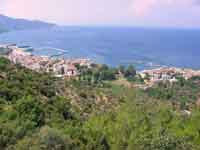.
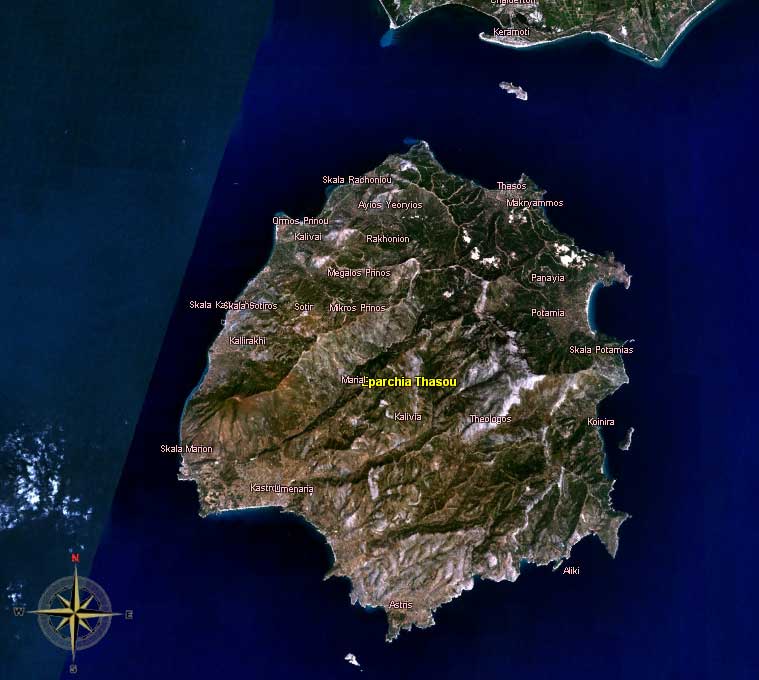
Thasos or Thassos (Greek: Θάσος) is a Greek island in the northern Aegean Sea, close to the coast of Thrace and the plain of the river Nestos but geographically part of Macedonia. It is the northernmost Greek island, and 12th largest by area. Thasos is also the name of the largest town of the island (also known as Limenas Thasou, "Harbour of Thasos"), situated at the northern side, opposite the mainland and about 10 kilometres (6 mi) from Keramoti.
History
Prehistory
Lying close to the coast of Eastern Macedonia, Thasos was inhabited from the Palaeolithic period onwards,[1] but the earliest settlement to have been explored in detail is that at Limenaria where Middle and Late Neolithic remains have been found that relate closely to those of the Drama Plain. In contrast, the remains of the Early Bronze Age on the island align it with the culture that developed in the Cyclades and Sporades to the south in the Aegean. At Skala Sotiros[2] for example, a small settlement was encircled by a strongly built defensive wall. Even earlier activity is demonstrated by the presence of large pieces of 'megalithic' anthropomorphic stelai built into these walls, which, so far, have no parallels in the Aegean area.
There is then a gap in the archaeological record until the end of the Bronze Age c 1100 BC, when the first burials took place at the large cemetery of Kastri in the interior of the island.[3][4] Here built tombs covered with small mound of earth were typical until the end of the Iron Age. In the earliest tombs were a small number of locally imitated Mycenaean pottery vessels, but the majority of the hand-made pottery with incised decoration reflects connections eastwards with Thrace and beyond.
Antiquity


Sculptures from Thasos
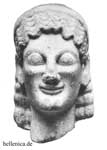
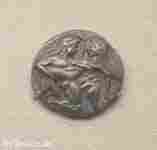
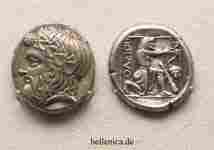
Thasos, Stater, Thasos Tetradrachma
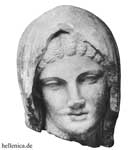
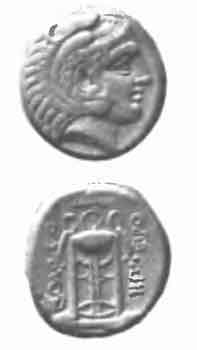
Thasos, Gold Stater, (Krinides) 357 BC Heracles and Tripod (THASION EPEIRO)
Hemiobolus of Thasos:Wreathed head of a nymph left/Dolphin leaping left within incuse square,circa 411-340 BC
The island was colonized at an early date by Phoenicians, attracted probably by its gold mines; they founded a temple to the god Melqart, whom the Greeks identified as "Tyrian Heracles", and whose cult was merged with Heracles in the course of the island's Hellenization.[5] The temple still existed in the time of Herodotus.[6] An eponymous Thasos, son of Phoenix (or of Agenor, as Pausanias reported) was said to have been the leader of the Phoenicians, and to have given his name to the island.
In either 720 or 708 BC, Thasos received a Greek colony from Paros. It was in a war the Parian colonists waged with the Saians, a Thracian tribe, that the poet Archilochus [7] threw away his shield. The Greeks extended their power to the mainland, where they owned gold mines even more valuable than those on the island. From these sources the Thasians drew great wealth, their annual revenues amounting to 200 or even 300 talents. Herodotus, who visited Thasos, says that the best mines on the island were those opened by the Phoenicians on the east side of the island facing Samothrace.
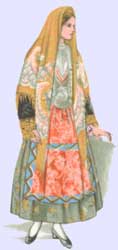
Thasos was important during the Ionian Revolt against Persia. After the capture of Miletus (494 BC) Histiaeus, the Ionian leader, laid siege. The attack failed, but, warned by the danger, the Thasians employed their revenues to build war ships [8] and strengthen their fortifications. This excited the suspicions of the Persians, and Darius compelled them to surrender their ships and pull down their walls. After the defeat of Xerxes the Thasians joined the Delian confederacy; but afterwards, on account of a difference about the mines and marts on the mainland, they revolted.
The Athenians defeated them by sea, and, after a siege that lasted more than two years, took the capital, Thasos, probably in 463 BC, and compelled the Thasians to destroy their walls, surrender their ships, pay an indemnity and an annual contribution (in 449 BC this was 21 talents, from 445 BC about 30 talents), and resign their possessions on the mainland. In 411 BC, at the time of the oligarchical revolution at Athens, Thasos again revolted from Athens and received a Lacedaemonian governor; but in 407 BC the partisans of Lacedaemon were expelled, and the Athenians under Thrasybulus were admitted.
Roman Era
Further information: Roman Greece
After the Battle of Aegospotami (405 BC), Thasos again fell into the hands of the Lacedaemonians under Lysander who formed a decarchy there; but the Athenians must have recovered it, for it formed one of the subjects of dispute between them and Philip II of Macedonia. In the embroilment between Philip V of Macedonia and the Romans, Thasos submitted to Philip, but received its freedom at the hands of the Romans after the battle of Cynoscephalae (197 BC), and it was still a "free" state in the time of Pliny.
It is related, that Byzantine Greek Saint Joannicius the Great (752 - 846) in one of his miracles freed the island of Thasos from a multitude of snakes.
Ottoman Era
Further information: Byzantine Greece and Ottoman Greece
Thasos was part of the Eastern Roman Empire, later known as Byzantine Empire. It was captured by the Turks in 1462. Under the Turks the island was known as Ottoman Turkish: طاشوز Taşöz. A brief revolt against Ottoman rule in 1821, led by Hajiyorgis Metaxas, failed. The island was given by the Sultan Mahmud II to Muhammad Ali of Egypt of as a personal fiefdom in the late 1820s, as a reward for Egyptian intervention in the War of Greek Independence (which failed to prevent the creation of the modern Greek state). Egyptian rule was relatively benign (by some accounts Muhammad Ali had either been born or spent his infancy on Thasos) and the island became prosperous, until 1908, when the New Turk regime asserted Turkish control. It had the status of a sanjak in the vilayet of Salonici until the Balkan Wars. On October 20, 1912 during the First Balkan War, a Greek naval detachment claimed Thasos as part of Greece, which it has remained since.
World War II
Further information: Axis occupation of Greece during World War II
During Axis occupation (1941–1944) Thasos, along with the rest of Eastern Macedonia and Thrace, was under Bulgarian control. The Bulgarians planned to annex the territory under their control and closed down schools as a first step towards forced Bulgarization. Under Bulgarian rule the island was called Тасос. Mountainous terrain facilitated small-scale resistance activity. The Greek Civil War affected the island in the form of skirmishes and Communist guerilla attacks until 1950, almost a year after the main hostilities were over on the mainland.
Modern Era
Limenaria / Thasos in 1950's
Church in Thasos
Thasos, the capital (now informally known as Limenas, or "the port"), stood on the north side of the island, and had two harbors. Archilochus described Thasos as "an ass's backbone crowned with wild wood," and the description still suits the mountainous island with its forests of fir and pine. Besides its gold mines, the wine, nuts and marble of Thasos were well known in antiquity. Thasian wine (a light bodied wine with a characteristic apple scent) was, in particular, quite famous; to the point where all Thasian coins carried the head of the wine god Dionysos on one side and bunches of grape of the other.[9]
Thasos is served by ferry routes to and from Kavala and Keramoti. The latter is a port close to Kavala International Airport, and has the shortest possible crossing to the island.
Administration
Thasos is a separate peripheral unit of the East Macedonia and Thrace periphery, and the only municipality of the peripheral unit.[10] As a part of the 2011 Kallikratis government reform, the peripheral unit Thasos was created out of the former Kavala Prefecture. The municipality, unchanged at the Kallikratis reform, includes a few uninhabited islets besides the main island Thasos.
Geography
Thasos from space, April 1993
Thasos has generally round shape, without deep bays and significant peninsulas. The highest peak, Ypsario or Ipsario, is 1,205 m (3428 ft) high and lies in the eastern half of the island, which is steeper and mostly covered in pine forest. The western half has gentler slopes. While generally mountainous, the terrain is not particularly rugged, as it rises gradually from the coast towards the island center.
Most villages were placed inland, as the population was chiefly engaged in agriculture and stockbreeding. Those villages had their harbors at nearest points on the shore, often connected with stairways ("Skalas") and the population gradually migrated there, as tourism began to emerge as an important source of income. Thus, there are several pairs of villages such as Marion–Skala Maries, where the former is inland and the latter on the coast.
Geology
Geological and Metallogenic map of Thasos Island.

Geological and Metallogenic map of Thasos Island.
|
|
|
|
Thasos island is located in the northern Aegean sea approximately 7 km from the mainland and 20 km south-east of Kavala. The Island is formed mainly by gneisses, schists and marbles of the Rhodope Massif. Marble sequences, corresponding to the Falacron Marbles intercalated by schists and gneisses, are up to 500m thick and are separated from the underlying gneisses by a transition zone about 300 m thick termed the T-zone consisting of alternances of dolomitic and calcitic marbles intercalated by schists and gneisses.
The rocks have undergone several periods of regional metamorphism, to at least upper amphibolite facies, and there was a subsequent phase of retrograde metamorphism. At least three periods of regional deformation have been identified, the most important being large scale isoclinal folding with axes aligned north-west. The T-zone is deformed and is interpreted by some authors as a regional thrust of pre-major folding age. There are two major high angle fault systems aligned north-west and north-east respectively. A large low-angle thrust cuts the gneiss, schist and marble sequence at the south-west corner of the island, probably indicating an overthrusting of the Serbomacedonian Massif onto the Rodope Massif.
The Late Miocene oil-producing Nestos-Prinos basin is located between Thassos island and the mainland. The floor of the basin is around 1,500 m deep off the Thassos coast(South Kavala ridge; Proedrou, 1988) and up to 4.000-5.000 m in the axial sector between Thassos and the mainland. The basin is filled with Late Miocene-Pliocene sediments, including ubiquitously repeated evaporite layers of rock salt and anhydrite-dolomite that alternate with sandstones, conglomerates, black shales, and uraniferous coal measures (Proedrou, 1979, 1988; Taupitz, 1985). Stratigraphically equivalent rocks on the mainland are clastic sediments with coal beds, marine to brackish fluvial units and travertines.
Mining history
Mining activities for base and precious metals started in the 7th century B.C. with the Phoenicians, followed in the 4th century by the Greeks and then the Romans. The mining was both open - pit and underground, and concentrated on the numerous karst hosted calamine deposits for lead and silver although there was also minor exploitation of gold and copper. Worth mentioning is the discovery of a paleolithic addit located at Tzines iron mine, whose age has being estimated at approximately 15.000 years old, (Kovkouli et al. 1988) for the exploitation of limonitic ochre.
More recently, mining companies such as Speidel (1905–1912) and Vielle Montagne (1925–1930) exploited the Zn-Pb (calamine) ores, which had reported grades over 12% Zn+Pb. In 1905 a metallurgical plant was erected at Limenaria for the calcination of the calamines in vertical and Oxland furnaces to produce ZnO. Later (1926) the calcination plant was rebuilt by Vieille Montagne with Waelz system rotary furnaces. Iron ore mining became important during the years 1954-1964. Several mining companies (Krupp and Apostolopoulos A.E., Chondrodimos S.A.) exploited the iron ore deposits of the island. It is estimated that total mineral production during the period 1905-1964 was about 2 million tonnes of calamine (12% Zn+Pb) and 3 million tonnes of iron ore (44% Fe). Since 1964 there has been no mining activity on the island.
A new exploration effort was initiated in 1976 by IGME aimed at locating hidden primary base metal mineralization. Core drilling resulted in the discovery at the Marlou prospect, in 1979, of a stratabound primary Zn-Pb deposit at a depth of 200 m. The marble quarrying had a parallel history with the mining activity of the Byzantine period. In the present era, starting about forty years ago, marble quarrying has been the only activity extracing the mineral wealth of Thasos.

Phidippides, Polygnotos Vagis

Polygnotos Vagis (14.1.1892 Potamia Thasos, 15.4.1965 New York) http://utopia.duth.gr/~museum/Biogr.html

First Crude Oil since 1981 from Thasos
References
- Antje and Günther Schwab: Thassos - Samothraki, 1999, ISBN 3-932410-30-0.
Satyr and Nymph Coins from Thasos
Division of the Thasos municipality , population 13765 (2001)
- Thasos / Δ.δ. Θάσου [ 3.140 ]
- Thasos / η Θάσος [ 3.130 ]
- Glyfada / η Γλυφάδα [ 7 ]
- Makryammos / η Μακρυάμμος [ 3 ]
- Thasos / η Θάσος [ 3.130 ]
- Theologos / Δ.δ. Θεολόγου [ 1.748 ]
- Theologos / ο Θεολόγος [ 731 ]
- Aliki / η Αλυκή [ 39 ]
- Astris / η Αστρίς [ 129 ]
- Thimonia / η Θυμωνιά [ 13 ]
- Koinyra (island) / η Κοίνυρα (νησίδα) [ 4 ]
- Koinyra / τα Κοίνυρα [ 104 ]
- Moni Archangelou / η Μονή Αρχαγγέλου [ 40 ]
- Palaichorion / το Παλαιοχώριον [ 0 ]
- Potos / ο Ποτός [ 688 ]
- Theologos / ο Θεολόγος [ 731 ]
- Kallirachi / Δ.δ. Καλλιράχης [ 1.282 ]
- Kallirachi / η Καλλιράχη [ 651 ]
- Skala Kallirachi / η Σκάλα Καλλιράχης [ 631 ]
- Kallirachi / η Καλλιράχη [ 651 ]
- Limenaria / Δ.δ. Λιμεναρίων [ 2.452 ]
- Kastron / το Κάστρον [ 11 ]
- Limenaria / τα Λιμενάρια [ 2.441 ]
- Kastron / το Κάστρον [ 11 ]
- Maries / Δ.δ. Μαριών [ 559 ]
- Maries / οι Μαριές [ 182 ]
- Skala Marion / η Σκάλα Μαριών [ 377 ]
- Maries / οι Μαριές [ 182 ]
- Panagia / Δ.δ. Παναγίας [ 849 ]
- Panagia / η Παναγία [ 820 ]
- Chrysi Ammoudia / η Χρυσή Αμμουδιά [ 29 ]
- Panagia / η Παναγία [ 820 ]
- Potamia / Δ.δ. Ποταμιάς [ 1.262 ]
- Potamia / η Ποταμιά [ 1.216 ]
- Lefki / η Λεύκη [ 46 ]
- Potamia / η Ποταμιά [ 1.216 ]
- Prinos / Δ.δ. Πρίνου [ 1.361 ]
- Megalos Prinos / ο Μεγάλος Πρίνος (τ. ο Πρίνος) [ 30 ]
- Iera Moni Agiou Panteleimonos / η Ιερά Μονή Αγίου Παντελεήμονος [ 3 ]
- Mikros Prinos / ο Μικρός Πρίνος [ 21 ]
- Ormos Prinou / ο Όρμος Πρίνου [ 122 ]
- Prinos / ο Πρίνος (τ. οι Καλύβες) [ 1.185 ]
- Megalos Prinos / ο Μεγάλος Πρίνος (τ. ο Πρίνος) [ 30 ]
- Rachonion / Δ.δ. Ραχωνίου [ 720 ]
- Rachonion / το Ραχώνιον [ 365 ]
- Agios Georgios / ο Άγιος Γεώργιος(Δ.δ. Ραχωνίου) [ 149 ]
- Skala Rachoniou / η Σκάλα Ραχωνίου [ 206 ]
- Rachonion / το Ραχώνιον [ 365 ]
- Sotir / Δ.δ. Σωτήρος [ 392 ]
- Skala Sotiros / η Σκάλα Σωτήρος [ 368 ]
- Sotir / ο Σωτήρ [ 24 ]
- Skala Sotiros / η Σκάλα Σωτήρος [ 368 ]
Economy
The main agricultural production on the island are honey and olive oil as well as wine, sheep, goat herding and fishing. Other industries includes lumber and tourism. Mining industry includes lead, zinc and marble, especially in the Panagia area where one of the mountains near the Thracian Sea has a large marble quarry. Now abandoned marble quarry in the south (in the area of Aliki) has been mined during the ancient times. By far the most important economic activity is tourism.
Communities
Thasos centre
Towns and villages with over 100 inhabitants are:
Agios Georgios (pop. 149)
Astris (129)
Kallirachi (651)
Kinyra (104)
Limenaria (2,441)
Maries (182)
Ormos Prinou (122)
Panagia (820)
Potamia (1,216)
Potos (688)
Prinos (1,185)
Rachoni (365)
Skala Kallirachis (631)
Skala Marion (377)
Skala Rachoniou (206)
Skala Sotirou (368)
Thasos (Limenas Thasou) (3,130)
Theologos (731)
Historical population
Year Town Municipality
1981 2,312 -
1991 2,600 -
2001 - 13,765
Notable people
Archilochos (7th c. BC) warrior and poet. "You led us a thousand strong at Thasos, fields fattened by corpses."
Aglaophon (6-5th c. BC) painter, teacher and father of Polygnotus and Aristophon [1]
Hegemon of Thasos comedian, inventor of parody
Leodamas (4th century BC) mathematician
Neseus of Thasos, painter
Polygnostos Vagis (1892–1965) Thasos-born US sculptor
Polygnotus (middle of 5th c.BC), painter
Stesimbrotos (c. 470 BC-c. 420 BC) sophist
Theagenes Olympic boxer (480 BC), Pankratiast(476 BC) and runner [2]
Vassilis Vassilikos (1934) poet and author
Demetrios Vassiliades (1958) Indologist scholar and author
See also
Communities of the Kavala prefecture, including Thasos
Bibliographic references
Agelarakis A., "Linen Thread Fragment". Ed. Chi. Koukouli-Chrysanthaki. “Proto-Historic Thasos”, Archaeologiko Deltio 2.45 (1992–1993): 803
Agelarakis A., "Investigations of Archaeo-Anthropological Nature at the Classical Necropolis of the Island of Thasos between 1979-1996", Archaiologiko Ergo sti Makedonia kai Thraki , 10B (1997): 770-794.
Agelarakis A., "On the Anthropological and Palaeopathological Records of a Select Number of Human Individuals from the Ancient Necropolis of Thasos Island". In <Jewelry from Thasian Graves> by Sgourou M., BSA 96 (2001): 355-364.
Agelarakis A., "Investigations of Physical Anthropology & Palaeopathology at the Ancient Necropolis of Thasos”, In M. Sgourou, <Excavating houses and graves: exploring aspects of everyday life and afterlife in ancient Thasos>, BAR International series 1031 (2002): 12-19.
Antje and Günther Schwab: Thassos - Samothraki, 1999, ISBN 3-932410-30-0.
N. Epitropou et al.: "The discovery of primary stratabound Pb – Zn mineralization at Thassos Island", L’ Industria Mineraria n. 4, 1982.
N. Epitropou, D. Konstantinides, D. Bitzios: "The Mariou Pb – Zn Mineralization of the Thassos Island Greece.", Mineral deposits of the Alps and of Alpine Epoch in Europe ed. by H. J. Echneibert, Spring – Verlag Berlin Heilderberg, 1983.
N. Epitropou et al.: "Le mineralizzazioni carsiche a Pb – Zn dell’ isola di Thassos, Grecia.", Mem. Soc. Geol. H. 22, 1981, pp. 139-143.
Omenetto P., Epitropou N., Konstantinides D.: "The base metal sulphides of W. Thassos Island in the Geological Metallogenic Frame work of Rhodope and Surrounding Regions.", International Earth Sciences Congress on AEGEAN Regions, 1–6 October 1990, Izmir -Turkey.
Epitropou N., Omenetto P., Constantinides D., "Μineralizations a Pb – Zn comparables au type ' Mississippi Valley'. L'example de l'ile de Thassos ( Macedoine, Grece du Nord)", MVT WORKSHOP, Paris, France, 1993.
References
This article incorporates text from a publication now in the public domain: Chisholm, Hugh, ed (1911). Encyclopædia Britannica (11th ed.). Cambridge University Press.
^ Papadopoulos S., "Recent Field Investigations in Paleolithic, Neolithic and Bronze Age Thasos", International Symposium in Memoriam Mieczislaw Domaradzki, Kazanlak, Archaeological Institute of Sofia, Kazanluk, (in press)
^ Κουκούλη Χ.- Χρυσανθάκη, "Ανασκαφή Σκάλας Σωτήρος Θάσου", Το Αρχαιολογικό Έργο στη Μακεδονία και Θράκη, 1, ((1987), 1988, 391-406, 2 (1988), 1991, 421-431, 3 (1989), 1992, 507-520, 4 (1990), 1993, 531-545).
^ Chaidou Koukouli-Chrysanthaki: Πρωτοιστορική Θάσος. Τα νεκροταφεία του οικισμού Κάστρι, Μερος Α και Β, Υπουργείο Πολιτισμού, Δυμοσιέυματα του αρχαιολογικού Δελτίου Αρ. 45, ISBN 960-214-107-7
^ Agelarakis A., "Reflections of the Human Condition in Prehistoric Thasos: Aspects of the Anthropological and Palaeopathological Record from the Settlement of Kastri". Actes du Colloque International Matières prèmieres et Technologie de la Préhistoire à nos jours, Limenaria, Thasos. The French Archaeological Institute in Greece, 1999. 447-468.
^ Pausanias, 5.25.12. "The Thasians, who are Phoenicians by descent, and sailed from Tyre, and from Phoenicia generally, together with Thasos, the son of Agenor, in search of Europa, dedicated at Olympia a Herakles, the pedestal as well as the image being of bronze. The height of the image is ten cubits, and he holds a club in his right hand and a bow in his left. They told me in Thasos that they used to worship the same Heracles as the Tyrians, but that afterwards, when they were included among the Greeks, they adopted the worship of Heracles the son of Amphitryon."
^ Herodotus. Histories, 2.44. "In the wish to get the best information that I could on these matters, I made a voyage to Tyre in Phoenicia, hearing there was a temple of Heracles at that place, very highly venerated. I visited the temple, and found it richly adorned with a number of offerings, among which were two pillars, one of pure gold, the other of smaragdos, shining with great brilliancy at night. In a conversation I held with the priests, I inquired how long their temple had been built, and found by their answer that they, too, differed from the Hellenes. They said that the temple was built at the same time that the city was founded, and that the foundation of the city took place 2,300 years ago. In Tyre I remarked another temple where the same god was worshipped as the Thasian Heracles. So I went on to Thasos, where I found a temple of Heracles, which had been built by the Phoenicians who colonised that island when they sailed in search of Europa. Even this was five generations earlier than the time when Heracles, son of Amphitryon, was born in Hellas. These researches show plainly that there is an ancient god Heracles; and my own opinion is that those Hellenes act most wisely who build and maintain two temples of Heracles, in the one of which the Heracles worshipped is known by the name of Olympian, and has sacrifice offered to him as an immortal, while in the other the honours paid are such as are due to a hero."
^ Zafeiropoulou F., A., Agelarakis, “Warriors of Paros”. Archaeology 58.1(2005): 30-35.
^ Agelarakis A., - Y., Serpanos "Auditory Exostoses, Infracranial Skeleto-Muscular Changes and Maritime Activities in Classical Period Thasos Island", Mediterranean Archaeology and Archaeometry, Vol. 10, No. 2, 2010, 45-57.
^ Hugh Johnson, Vintage: The Story of Wine pg 39. Simon and Schuster 1989
^ Kallikratis reform law textPDF
Greece :
A - B - C - D - E - F - G - H - I - J - K - L - M -
N - O - P - Q - R - S - T - U - V - W - X - Y - Z
| Ancient Greece
Science, Technology , Medicine , Warfare, , Biographies , Life , Cities/Places/Maps , Arts , Literature , Philosophy ,Olympics, Mythology , History , Images Medieval Greece / Byzantine Empire Science, Technology, Arts, , Warfare , Literature, Biographies, Icons, History Modern Greece Cities, Islands, Regions, Fauna/Flora ,Biographies , History , Warfare, Science/Technology, Literature, Music , Arts , Film/Actors , Sport , Fashion --- |
Retrieved from "http://en.wikipedia.org/"
All text is available under the terms of the GNU Free Documentation License
